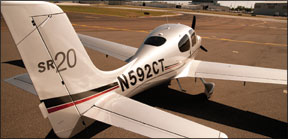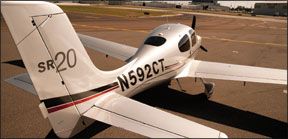Of all the major components of a conventional airplane, the tail—empennage, if you prefer—may be the least understood. Yes, we generally know it’s there to help balance and stabilize the airplane’s attitude in flight, and to help control yaw and pitch, but that’s often the extent to which we paid attention in ground school.

288
If we were paying more attention, we might have learned airplane tails come in many different shapes and sizes, and can be placed at either end of the airplane. They can be partially or totally omitted from some airplanes, while others might be considered to have more than one. Even relatively simple personal airplanes come in an assortment of tail shapes and sizes. Knowing how and why a specific airplane’s tail works the way it does can help us understand how to inspect it during preflight and how to fly it when airborne.
Three Basic Functions
First some ground rules: Let’s confine our discussion to airplanes with what we might consider “conventional” tails. By this we mean combining vertical and horizontal stabilizers into one basic assembly, versus a canard configuration.
Although this might seem limiting at first, it encompasses designs as diverse as Beechcraft’s Model 18 Twin Beech and Model 35 V-tail Bonanza, Cessna’s Model 336/337 Skymaster, plus T-tail designs like the Piper PA-28RT-201 Arrow and PA-32RT-300 Lance. The sidebar on page 11 highlights why some of these aircraft have the tails they do.
The important thing to remember when considering these different tail types? They all do basically the same things: provide stabilization and control in the vertical (yaw) axis, and in the lateral (pitch) axis, plus generate the downforce necessary to counter the nose’s tendency to pitch down when the airplane’s center of gravity is properly forward of its center of lift. Let’s first explore control about the lateral axis by discussing why we need downforce.
Balance and Pitch Control
What would happen if an airframe was designed so that its wing’s center of lift (CL) and its center of gravity (CG) were in precisely the same location? It would be incredibly unstable, for one thing, and its stall behavior would be unpredictable. And everything we might want to carry must be in that same exact location.
Instead, designers evolved a relatively simple fix: They placed the center of gravity forward of the center of lift. This has the happy effect of forcing the nose down when the wing stalls. It also means some method of exerting force to counter the moment created by placing the CG ahead of the CL must be employed. Enter the horizontal stabilizer, which in simple form is an airfoil mounted upside down. It creates the opposite of lift: downforce. The relative positions of CG, CL and downforce (D) are diagrammed above.
With common horizontal stabilizer/elevator designs, the amount of downforce created is determined by the elevator’s position and the stabilizer’s angle of attack. A stabilator, meanwhile, like the ones on Piper’s PA-28/32/34 series, is a one-piece design pivoting on a point somewhat aft of its leading edge. Its downforce greatly depends on its angle of attack.
When the elevator/stabilizer is deflected, its position determines how much downforce is generated. Greater downforce, of course, also generates more drag. But the downforce necessary to maintain the desired flight attitude can be minimized by loading the airplane so the elevator is more or less in-trail with the horizontal stabilizer, or the stabilator is streamlined. In all airplanes we can think of, moving the CG aft toward but not beyond the CL means less downforce is needed to manage pitch, and less drag is created, allowing faster cruising speeds on the same power.
Regardless of its design, the pitch control works the same way: In both cases, if we pull back on the yoke, greater downforce is created at the tail, rotating the airplane about its horizontal axis, acting through the CG, and pushing the nose up. In essence, then, a conventional tail’s horizontal surface works to help balance the airplane fore and aft, or through its lateral axis.
A final word, about pitch trim. Pitch trim tabs are mounted on the elevator/stabilator’s trailing edge and linked to a cockpit-mounted wheel, handle or electric trim system. With a conventional stabilizer/elevator design, the pitch trim tab is called a servo tab, and works opposite to the elevator: deflecting the trim/servo tab in one direction acts to deflect the elevator in the opposite direction. A stabilator’s trim device, on the other hand, is known as an anti-servo trim tab. When deflected, the anti-servo tab acts in the same direction, increasing the stabilator’s effectiveness.
The Vertical Axis
As the images on this and the next page illustrate, elevators and stabilators can be mounted in various ways, depending on engineering needs. So, it turns out, can the vertical stabilizer, which provides stability in the vertical axis by controlling yaw.
The vertical stabilizer usually is a single panel extending upward from the aft fuselage. Exceptions to the single-panel rule are shown on the opposite page, in the form of twin vertical stabilizers used on the Twin Beech and Skymaster. It’s a popular configuration on military airplanes like the F-15 and F/A-18. Triple vertical stabilizers also have been used, most famously on the Lockheed Constellation. In each instance, their job is the same: to minimize and control the airplane’s rotation about its vertical axis.
Also in each case, a rudder is attached, allowing the pilot to control yaw. Conventional multi-engine airplanes can require a larger vertical stabilizer and rudder, capable of exerting greater yawing moments, to deal with engine-out situations. Larger surfaces, of course, create greater drag than a smaller, similar design.
Yaw also can be termed “adverse yaw,” which usually is generated by aileron deflection. When the pilot commands a bank, the downward deflected aileron produces greater lift than the opposite wing, which results in the wing rising. But Aerodynamics 101 teaches us that any time lift is produced, so is drag. And it’s proportional. So, greater lift equals greater drag, and the act of raising a wing with aileron literally slows down that wing—thanks to the increased drag—inducing a yawing moment in the same direction.
Why is this yaw known as “adverse yaw”? Because it’s in direction opposite the desired bank, which acts to slow the rate of heading change when we enter a turn. Many modern airplanes are designed to minimize adverse yaw. Older ones and gliders? Not so much.
Like elevators/stabilizers, rudders also have trim tabs. Basic airplanes, like the Cessna 172, have a fixed tab while faster and heavier ones usually have one adjustable from the cockpit. Fixed tabs are simpler, but can be adjusted to center the inclinometer’s ball for only one airspeed. Like elevators, a rudder’s trim tab works as a servo tab: (carefully!) deflect or bend it opposite the direction in which you want to deflect the rudder.
Care And Feeding
A tail’s preflight inspection is straightforward, at least when compared to, say, the wings and their control surfaces. Look for loose hinges, abnormal play in the hinges, and visible damage. This applies not only to the elevator itself, but also to the trim tabs. When grasped on the ground, the rudder and elevator/stabilator must move smoothly throughout their full ranges of travel, without binding or noise.
Depending on the airplane, the tail surfaces will be connected to the cockpit controls via cables, pushrods or some combination. On many airplanes, the cable/pushrod is at least partially exposed. If so, look for corroded fittings or frayed cables. Ensure the pushrod ends are free to move and that any stop nuts are secure and properly safetied, if required.
Many of these surfaces may be placarded “No Push” or with some similar admonition. This does not mean you shouldn’t move the surface to inspect it. Rather, it means you should never push on the surface to move the airplane.
Most personal airplanes allow the average human to access all their components. For others, like a T-tail Arrow or Lance, you may need a ladder or stepstool. Don’t neglect this step: The tail you preserve may be your own.




